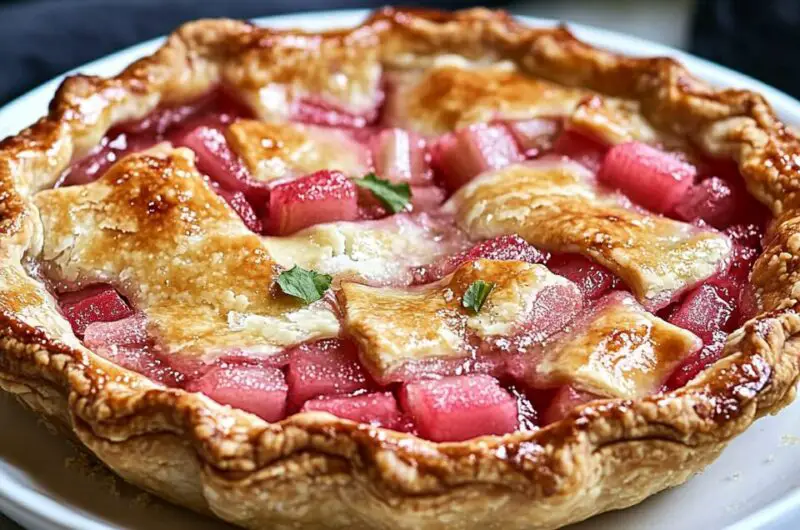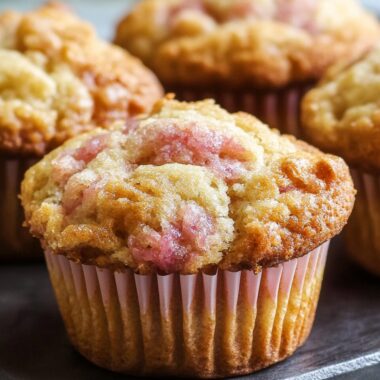The essence of spring is captured perfectly in this classic rhubarb pie. With its vibrant pink filling and flaky lattice crust, it’s a nostalgic nod to homemade desserts that never go out of style. This pie strikes the ideal balance between tart and sweet, letting the rhubarb shine while mellowing its bite with sugar, vanilla, and lemon. Perfect for gatherings, potlucks, or a weekend baking project, this rhubarb pie pairs beautifully with a scoop of vanilla ice cream or a dollop of whipped cream. Whether you’re a seasoned baker or trying something new, this simple yet elegant dessert is bound to impress and satisfy with each slice.
Full Recipe:
Ingredients:
-
1 double pie crust (store-bought or homemade)
-
6 cups fresh rhubarb, chopped
-
1 ⅓ cups granulated sugar
-
6 tablespoons cornstarch
-
¼ teaspoon salt
-
1 teaspoon vanilla extract
-
1 tablespoon lemon juice
-
2 tablespoons unsalted butter, cut into small pieces
-
1 egg + 1 tablespoon water, beaten (for egg wash)
-
Coarse sugar, for topping
Directions:
-
Preheat the oven to 425°F (220°C).
-
Roll out half of the pie dough and fit it into a 9-inch pie plate. Trim excess dough and refrigerate.
-
In a large bowl, combine rhubarb, sugar, cornstarch, salt, vanilla, and lemon juice. Stir well to coat evenly.
-
Pour the rhubarb mixture into the chilled pie crust. Dot the filling with pieces of butter.
-
Roll out the second half of the dough and cut into strips to create a lattice top. Weave the lattice over the pie and trim the edges. Crimp the edges to seal.
-
Brush the top with the egg wash and sprinkle with coarse sugar.
-
Place the pie on a parchment-lined baking sheet and bake for 20 minutes at 425°F.
-
Reduce heat to 375°F (190°C) and bake for another 40-45 minutes, or until the filling is bubbly and the crust is golden.
-
Let the pie cool completely before serving to allow the filling to set.
Prep Time: 30 minutes | Cooking Time: 65 minutes | Total Time: 1 hour 35 minutes
Kcal: 410 kcal per slice | Servings: 8 slices
Sweet-Tart Nostalgia: The Charm of a Classic Rhubarb Pie
There are some recipes that feel like a warm hug from the past comforting, slightly rustic, and brimming with memories. Classic rhubarb pie is one of those beloved dishes. With its vibrant ruby-red filling and buttery, golden crust, this pie is more than just dessert it’s tradition, heritage, and the perfect blend of tart and sweet. Whether you grew up picking rhubarb from your grandmother’s garden or are discovering this unique vegetable-turned-dessert for the first time, a rhubarb pie is an experience that captures the heart of homemade baking.
Let’s dive into the story, flavor, science, and art of this timeless pie and why it deserves a permanent spot in your seasonal baking rotation.
What Is Rhubarb, and Why Is It So Special?
Rhubarb is a perennial plant known for its long, celery-like stalks that range in color from pale green to deep crimson. Technically a vegetable, it’s most often used in sweet dishes because of its extremely tart flavor. While the stalks are edible, the leaves of the rhubarb plant contain oxalic acid and are toxic to humans, which is why they should always be discarded.
What makes rhubarb so beloved in baking is its unmistakable flavor profile. When cooked with sugar, rhubarb transforms from mouth-puckeringly sour to perfectly tangy-sweet. It holds its structure just enough to offer a delicate bite but softens beautifully in the oven, making it ideal for pies, crisps, and jams.
A Brief History of Rhubarb in Baking
Rhubarb has a surprisingly rich culinary history. Originally cultivated in China over 2,000 years ago for medicinal purposes, it was introduced to Europe in the 17th century. However, it wasn’t until sugar became more affordable in the 18th and 19th centuries that rhubarb gained popularity as a dessert ingredient.
In America, rhubarb pies became especially popular in the Midwest and Northern states, where rhubarb thrived in colder climates. It quickly earned nicknames like “pie plant” and was often one of the first crops harvested in spring, making it a staple for early-season desserts.
Why We Love Rhubarb Pie: Texture, Flavor, and Tradition
So, what makes this pie stand out from the crowd?
-
The Flavor: Rhubarb’s tartness is its claim to fame. Unlike fruit pies that lean heavily into sweetness, rhubarb pie offers a balance that keeps your taste buds on their toes. The sugar used in the filling doesn’t just sweeten it enhances and rounds out the bold flavor of the rhubarb.
-
The Texture: A well-made rhubarb pie offers layers of contrasting textures: a crispy, flaky crust that gives way to a lush, soft, jammy filling. The lattice top (a common presentation) allows steam to escape and helps concentrate the filling as it bakes.
-
The Tradition: Rhubarb pie is often handed down through generations. Many families have their own cherished versions some with hints of cinnamon or ginger, others paired with strawberries, and still others left purely rhubarb for a bold, old-fashioned experience.
Common Variations and Twists on the Classic
While the classic recipe keeps the focus on rhubarb itself, there are several popular variations that you may want to explore:
-
Strawberry-Rhubarb Pie: The most famous variation. Strawberries add sweetness and color, creating a beautiful, fruit-forward flavor.
-
Ginger-Rhubarb Pie: Adds a spicy, warming element that pairs beautifully with rhubarb’s tartness.
-
Orange or Citrus Zest: A splash of orange or lemon zest can brighten the pie further and add a refreshing twist.
-
Crumb Topping: Swap the lattice crust for a streusel-like crumb topping for added crunch and richness.
You can also experiment with herbs like basil or mint in small amounts for a subtle infusion or use alternative sweeteners like honey or maple syrup for different layers of complexity.
Tips for the Perfect Rhubarb Pie
If you want to master this dish and consistently produce a stunning rhubarb pie, consider these expert tips:
-
Use Fresh Rhubarb When Possible: While frozen rhubarb can work in a pinch, fresh rhubarb gives the best texture and flavor. Make sure to thaw and drain frozen rhubarb well to avoid excess moisture.
-
Cut Evenly: Chop rhubarb into uniform pieces to ensure even cooking throughout the filling.
-
Let It Set: Allow the pie to cool completely before slicing. This gives the filling time to thicken and hold its shape, rather than running all over the plate.
-
Watch the Sugar: Adjust sugar based on the tartness of your rhubarb. Young rhubarb is often more tender and less sour, so you may need less sugar.
-
Use a Baking Sheet: Rhubarb pie tends to bubble over, especially if packed full. Place it on a baking sheet lined with parchment paper to prevent a sticky oven mess.
-
Crust is Key: Whether you’re using a store-bought crust or making your own, make sure it’s chilled well before baking. A cold crust leads to flakier layers.
Serving Suggestions
Rhubarb pie is wonderfully versatile when it comes to serving options. Traditionally, it’s served simply either warm or room temperature. However, a few additions can elevate your experience:
-
A scoop of vanilla ice cream (a classic choice)
-
A dollop of whipped cream
-
A drizzle of honey or caramel for added sweetness
-
A sprinkle of powdered sugar before serving for presentation
Some even enjoy it chilled the next morning with a cup of strong coffee or black tea a nod to its rustic, farmhouse roots.
Seasonal Appeal: A Spring and Summer Favorite
Rhubarb is one of the first signs that spring has truly arrived. Its brief growing season (usually from April to June in most regions) makes it a treasured ingredient for a few short months. That scarcity is part of what makes rhubarb pie so special. When it’s gone, it’s gone until next year.
Baking with rhubarb often feels like a seasonal ritual, one that connects you to the cycles of nature, the traditions of family, and the joys of fresh, local produce.
Conclusion:
The classic rhubarb pie isn’t just a dessert it’s a bridge to history, tradition, and the bounty of springtime gardens. Its contrast of tart and sweet is an ideal metaphor for life’s little complexities, and the act of making it from scratch rolling the crust, stirring the filling, weaving the lattice is a delicious way to slow down and appreciate the art of home baking.
If you’ve never made one before, this is the perfect time to start. And if you have, then you know: few things rival the satisfaction of that first bite of rhubarb pie, where buttery crust meets tender, tangy filling in a perfect harmony of flavors.








